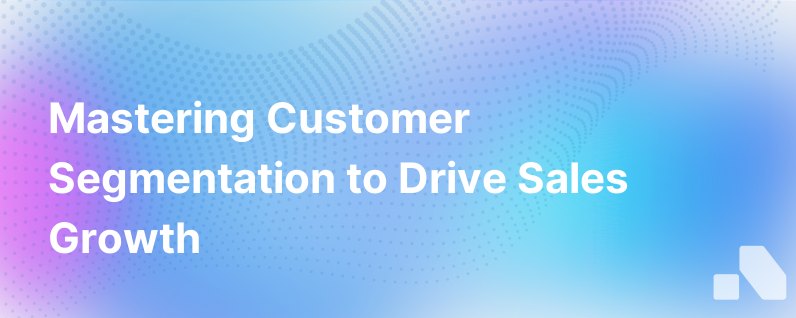
In the universe of marketing strategies, customer segmentation stands out as a critical approach to understanding and engaging with diverse customer groups. This technique not only empowers businesses to tailor their efforts but also aids in aligning product development, customer service, and marketing communication to various customer needs and potential value to the company.
Customer segmentation isn’t just about categorizing customers; it's an art and science that ensures each group receives personalized interactions, leaving them feeling valued and understood. It's about uncovering the unique preferences and behaviors of different segments to create more impactful marketing strategies.
For businesses striving to compete in today’s customer-centric world, implementation of a robust segmentation process isn't an option; it is a necessity.
What is Customer Segmentation?
Customer segmentation is the process of dividing customers into groups based on common characteristics. The aim is to enable companies to market more effectively to target audiences. Segmentation often includes subdividing big, heterogeneous markets into smaller segments that can be reached more efficiently and effectively with products and services tailored to their unique needs.
The Benefits of Customer Segmentation
Strategic Focus: It provides a strategic focus, allowing companies to hone in on specific market segments to fulfill their requirements, solve their pain points, and respond to market opportunities.
Efficient Resource Allocation: Through segmentation, businesses can allocate their resources more efficiently by targeting the segments most likely to convert or generate the highest lifetime value.
Enhanced Competitiveness: By understanding customer segments, companies can identify underserved or niche markets and develop specialized offerings that competitors may overlook.
Customer Retention: Tailored messages resonate deeper. Segmentation enables businesses to increase customer loyalty and retention by engaging with them on a more personal level.
Pricing Optimization: It enables businesses to optimize their pricing strategy by understanding the financial capacity and willingness to pay within each segment.
The Techniques of Customer Segmentation
Demographic Segmentation: One of the most common approaches divides the market based on variables such as age, gender, income level, occupation, education, household size, or marital status.
Geographic Segmentation: This technique sorts customers based on their physical location, understanding that preferences can vary widely between different regions, climates, and urbanization levels.
Psychographic Segmentation: Diving into the psychological aspects, this method segments customers based on lifestyle, values, attitudes, and personality traits, acknowledging that buying decisions are often influenced by these factors.
Behavioral Segmentation: This segments customers based on their knowledge of, attitude towards, use of, or response to a product, including patterns of use, price sensitivity, brand loyalty, and benefits sought.
In practice, a business might combine several segmentation techniques to build a nuanced view of their market.
Actionable Steps in Implementing Customer Segmentation
-
Data Collection: Gather quantitative and qualitative data related to customer demographics, behavior, purchase patterns, and preferences. Customer surveys, sales data, social media analytics, and website interactions are rich sources of insight.
-
Data Analysis: Use statistical analysis methods and data visualization tools to sift through the data and identify patterns that can inform your segmentation strategy.
-
Segment Development: Develop segments based on the patterns observed. Ensure each segment is substantial enough to target, accessible to your marketing efforts, differentiable from other segments, and actionable.
-
Segment Evaluation: Evaluate the commercial viability of each segment by estimating segment size, growth potential, current competitive presence, and overall profitability.
-
Targeting: Select segments that align best with your business goals and resources. Not all segments are equal – some may be more attractive based on size, profitability, or strategic importance.
-
Positioning Strategy: Develop a unique selling proposition (USP) and positioning strategy tailored to each segment. This should speak directly to the segment's needs and desired benefits.
-
Marketing Mix: Customize your marketing mix – product, price, place, and promotion – to best serve each segment. This could mean specialized product features, segmented pricing strategies, targeted distribution methods, and tailored promotional campaigns.
-
Review and Iterate: Customer segments can evolve. Regularly review your segments and adapt your strategies as necessary. Ongoing analysis will help identify new segments or changes in existing ones.
Common Pitfalls in Customer Segmentation
Avoid viewing segments as static - they should be dynamic and reflect evolving market trends. Avoid over-segmentation where segments become too small to be worth targeting, or under-segmentation where the segments are too broad, leading to lost opportunities for personalization. Ensure that segmentation is not solely based on internal assumptions – actual customer data is crucial.
Additionally, ensure compliance with data privacy laws when collecting and using customer data for segmentation.
Conclusion
Customer segmentation is an invaluable strategy for modern-day businesses looking to gain a competitive edge in the marketplace. By understanding the unique characteristics and preferences of different customer groups, companies can deliver more targeted marketing strategies that resonate on a personal level.
In summary, effective customer segmentation enables businesses to optimize resources, sharpen their marketing focus, and create more compelling product offerings, ultimately driving growth and customer loyalty.
For B2B sales platforms like Aomni, understanding the nuances of customer segmentation helps inform the development of strategic sales tools that facilitate delivering customized experiences, ultimately leading to better alignment with customer needs and increased sales efficiencies.